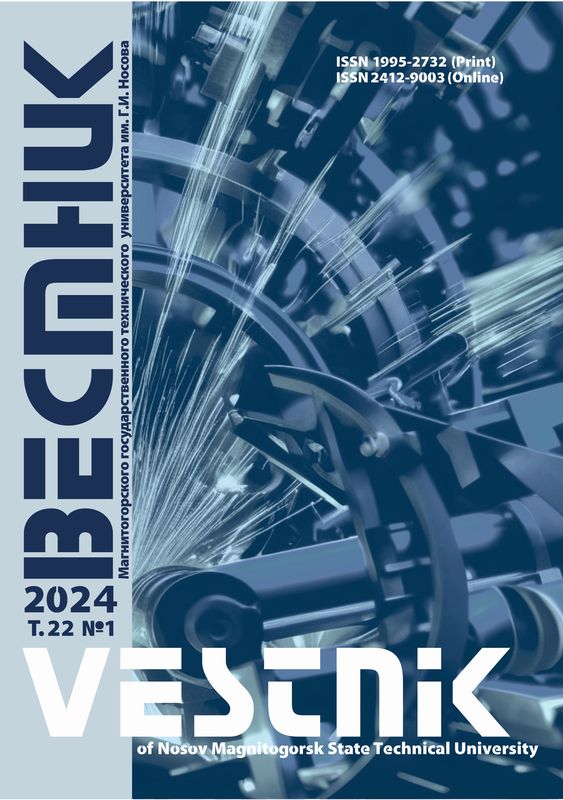DOI: 10.18503/1995-2732-2024-22-1-88-97
Abstract
Problem Statement (Relevance). Excessively high expenses result from an impossibility to make an optimal choice of coating modes in production. This is attributed to a need to stop the production and complexities of readjusting technological equipment. A crucial and critical technological process at the electroplating shop of Public Joint Stock Company Kalinin Machine-Building Plant, Yekaterinburg (PJSC MZIK) is an anodizing of aluminum and its alloys in a sulfuric acid solution. However, it is still not possible to improve the quality of anodic oxide coatings, leading to excessive costs. Objectives. The paper is aimed at analyzing and classifying anodic oxide coating defects found on deformable aluminum alloys, using statistical analysis tools, as well as applicability of statistical methods of quality management at the electroplating shop of PJSC MZIK. Methods Applied. To identify a key problem associated with causes of defects, an analysis was carried out using a Pareto chart. To assess in detail factors, presenting a main cause for the most significant defects, a causal diagram was built using a “brainstorming” method. Results and Practical Relevance. The causes for detected defects were determined and the corrective measures were developed to eliminate them. It has been shown that the statistical methods contributed to decreasing a share of defects and find “bottlenecks” at all the process stages. The results can be used as a basis for creating an object behavior model, which is a component of the virtual element of the digital twin.
Keywords
statistical methods, Pareto chart, causal diagram, Ishikawa diagram, anodizing of aluminum and its alloys in sulfuric acid, anodic oxide coating on aluminum and its alloys
For citation
Efremov A.N. Using Statistical Methods for Analyzing Defects of Anodic Oxide Coatings on Deformable Aluminium Alloys. Vestnik Magnitogorskogo Gosudarstvennogo Tekhnicheskogo Universiteta im. G.I. Nosova [Vestnik of Nosov Magnitogorsk State Technical University]. 2024, vol. 22, no. 1, pp. 88-97. https://doi.org/10.18503/1995-2732-2024-22-1-88-97
1. Skopintsev V.D., Margolin L.N., Farafonov V.L. Development of the anodizing technology for aluminum and its alloys. Review of publications for 2007-2018. Galvanotekhnika i obrabotka poverkhnosti [Electroplating and Surface Treatment]. 2019;27(2):9-22. (In Russ.) DOI: 10.47188/0869-5326-2019-27-2-9
2. Pecherskaya E.A., Golubkov P.E., Karpanin O.V., Kozlov G.V., Zinchenko T.O., Smogunov V.V. The influence of technological parameters on the properties of coatings synthesized by microarc oxidation. Izmerenie. Monitoring. Upravlenie. Kontrol [Measuring. Monitoring. Management. Control]. 2020;(2(32)):89-99. (In Russ.) DOI: 10.21685/2307-5538-2020-2-11
3. Poznyak A.A., Pligovka A., Laryn T., Salerno M. Porous alumina films fabricated by reduced temperature sulfuric acid anodizing: morphology, composition and volumetric growth. Materials. 2021;14(4):1-16. DOI: 10.3390/ma14040767
4. Enkeleda Dervishi, Michael McBride, Randall Edwards, Moraya Gutierrez, Nan Li, Raven Buntyn, Daniel E. Hooks. Mechanical and tribological properties of anodic Al coatings as a function of anodizing conditions. Surface and Coatings Technology. 2022;444:128652. DOI: 10.1016/j.surfcoat. 2022.128652
5. Patermarakis G. The multimodal dependence of anodic alumina film porous nanostructure on anodizing potential. Current Topics in Electrochemistry. 2020;22:1-17.
6. Jeanette M. Torrescano-Alvarez, Michele Curioni, Xiaorong Zhou, Peter Skeldon. Effect of anodizing conditions on the cell morphology of anodic films on AA2024-T3 alloy. Surface and Interface Analysis. 2019;51(12):1135-1143. DOI: 10.1002/sia.6562
7. Patermarakis G., Triantis T.M. Transformation of porous nanostructure and self-ordering of anodic alumina films during potentiostatic anodizing of aluminium. Current Topics in Electrochemistry. 2019;21:21-39.
8. Efremov A.N. A mathematical model for predicting thickness of the anodic oxide coating on AMg6 aluminum alloy. Vestnik Kontserna VKO Almaz – Antey [Journal of Almaz – Antey Air and Space Defense Corporation]. 2023;(2):66-80. (In Russ.) DOI: 10.38013/ 2542-0542-2023-2-66-80
9. Yudin S.V., Ostapenko S.N., Protasiev V.B., Krivov A.S., Guryanov V.P., Yudin A.S., Volkov M.V., Palikhov G.V. Upravlenie kachestvom. Sovremennye statisticheskie metody kontrolya i upravleniya kachestvom produktsii v proizvodstve [Quality management. Modern statistical methods of product quality control and management in industry]. Moscow: 2020, 184 p. (In Russ.)
10. Efremov A.N. Architecture of a mathematical model for predicting the quality of anodic oxide coatings on aluminum and its alloys. Evraziiskiy soyuz uchenykh. Seriya: Tekhnicheskie i fiziko-matematicheskie nauki [The Eurasian Union of Scientists. Series: Technical and Physical and Mathematical Sciences]. 2022;1(10(103)):6-13. (In Russ.) DOI: 10.31618/ ESU-2413-9335-2022-1-103-1730












